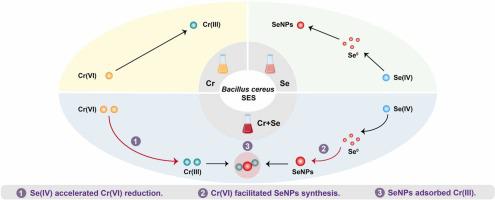Journal of Hazardous Materials ( IF 13.6 ) Pub Date : 2023-05-25 , DOI: 10.1016/j.jhazmat.2023.131713 Min Nie 1 , Miaomiao Cai 2 , Chihhung Wu 3 , Shiqian Li 4 , Suhua Chen 5 , Guangyu Shi 6 , Xu Wang 7 , Chengxiao Hu 2 , Jiatao Xie 2 , Yanni Tang 2 , Huan Zhang 2 , Xiaohu Zhao 2

|
Microbial biotransformation of Cr(VI) is a sustainable approach to reduce Cr(VI) toxicity and remediate Cr(VI) contamination. In this study, Bacillus cereus SES with the capability of reducing both Cr(VI) and Se(IV) was isolated, and the effect of Se supplementation on Cr(VI) reduction by Bacillus cereus SES was investigated. Se(IV) addition enabled 2.6-fold faster Cr(VI) reduction, while B. cereus SES reduced 96.96% Se(IV) and produced more selenium nanoparticles (SeNPs) in the presence of Cr(VI). Co-reduction products of B. cereus SES on Cr(VI) and Se(IV) were SeNPs adsorbed with Cr(III). The relevant mechanisms were further revealed by proteomics. Se(IV) supplementation mediated the synthesis of Cr(VI) reductants and stress-resistant substances, thus enhancing Cr(VI) resistance and promoting Cr(VI) reduction. Meanwhile, high Se(IV) reduction rate was associated with Cr(VI)-induced electron transport processes, and Cr(VI) mediated the up-regulation of flagellar assembly, protein export and ABC transporters pathways to synthesis and export more SeNPs. Furthermore, Se combined with B. cereus SES had the potential to reduce the toxicity of Cr(VI) via reducing the bioavailability of Cr and improving the bioavailability of Se in soil. Results suggested that Se could be an efficient strategy to enhance the remediation of B. cereus SES on Cr contamination.
中文翻译:

硒介导的 Cr(VI) 还原和 SeNPs 合成加速蜡样芽孢杆菌 SES 修复 Cr 污染
Cr(VI) 的微生物生物转化是降低 Cr(VI) 毒性和修复 Cr(VI) 污染的可持续方法。本研究分离了具有还原Cr(VI)和Se(IV)能力的蜡样芽孢杆菌SES,并研究了补硒对蜡样芽孢杆菌SES还原Cr(VI)的影响。添加 Se(IV) 可使 Cr(VI) 还原速度加快 2.6 倍,而蜡样芽孢杆菌SES 还原 96.96% Se(IV),并在 Cr(VI) 存在的情况下产生更多的硒纳米颗粒 (SeNP)。蜡样芽孢杆菌的共还原产物Cr(VI) 和 Se(IV) 上的 SES 是吸附有 Cr(III) 的 SeNPs。蛋白质组学进一步揭示了相关机制。补充Se(IV)介导Cr(VI)还原剂和抗应激物质的合成,从而增强Cr(VI)抗性并促进Cr(VI)还原。同时,高 Se(IV) 还原率与 Cr(VI) 诱导的电子传递过程相关,Cr(VI) 介导鞭毛组装、蛋白质输出和 ABC 转运蛋白途径的上调,从而合成和输出更多 SeNP。此外,Se 与B. cereus SES 结合有可能通过降低 Cr(VI) 的生物利用度并提高土壤中 Se 的生物利用度来降低 Cr(VI) 的毒性。结果表明,硒可能是加强修复的有效策略B. cereus SES 对 Cr 污染的影响。


























 京公网安备 11010802027423号
京公网安备 11010802027423号